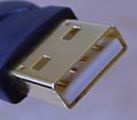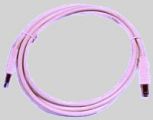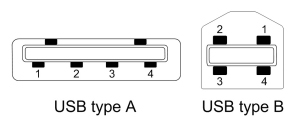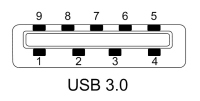USB - Universal Serial Bus
USB 1.1: 12 Mbps
USB 2.0: 480 Mbps
USB 1.1
is a single, standardized, easy-to-use way to connect up to 127 devices to a computer. Because of its relatively slow transfer rate of 12 Mbps, USB is used as a connector of devices that donít need tremendous bandwidth, like mice, printers, scanners, etc. It combines all advantages of a multi-platform standard (cost efficiency , auto-configuration, increased compatibility,
larger number of available peripherals.
Three different devices are possible in the USB network: hosts, hubs and functions.
Hosts are the main, initiating devices like PCs. A maximum number of 5 hubs can be installed in one network. Only one host can be established in one network.
Functions are devices like keyboards, printers, etc. Hubs are multi-port repeaters as distribution devices in the network. The connections require no terminators, memory addresses or ID numbers.
Unlike FireWire, USB controls peripheral devices in a master/slave relationship.
It is hot-pluggable, eliminating the need to turn off or restart the computer when attaching a new peripheral.
 | |
 | |
 |
| USB A Connector | |
USB B Connector | |
USB Cable |
USB also provides power to the bus, enabling many peripherals to operate without the added need for an AC power adapter. One single style of cable (USB A-B) is used (two pairs 20-28 AWG wires for power distribution and data transmission). The cable has different connectors at each end, so they canít be plugged in incorrectly.
Shielded Twisted Pair cable (STP) is normally used and enables a speed of 12 Mbps. Using Unshielded Twisted Pair cable (UTP), only a speed of 1.5 Mbps is possible. The unshielded UTP cable consists also of two 20-28 AWG pairs for power and data. This cable is used only for sub-channel applications. The maximum cable length is 5 meter for STP cable and 1.5 meter for UTP cable.
 |
Pin |
Signal |
Color |
1 |
VCC |
Red |
2 |
D- (-Data) |
White |
3 |
D+ (+Data) |
Green |
4 |
GND |
Black |
|
| Pinout USB 1.1 and 2.0 | |
USB 2.0
The high-speed USB 2.0 features a maximum transfer rate thatís forty times faster than USB 1.1, 480mbps.
Intel's new motherboard chipsets for Pentium 4 processors will include the new USB 2.0 standard and Microsoft supports USB 2.0 in Windows XP.
Adaptec just released the 'DuoConnect', combination USB 2.0/1394 Firewire card.
USB 3.0
 |
Pin |
Signal |
Color |
1 |
VBUS +5V DC |
Red |
2 |
D- (-Data) |
White |
3 |
D+ (+Data) |
Green |
4 |
GND |
Black |
5 |
USB3 RX- |
Blue |
6 |
USB3 RX+ |
Yellow |
7 |
GND |
(blank) |
8 |
USB3 TX- |
Violet |
9 |
USB3 TX+ |
Orange |
|
| Pinout USB 1.1 and 2.0 | |








